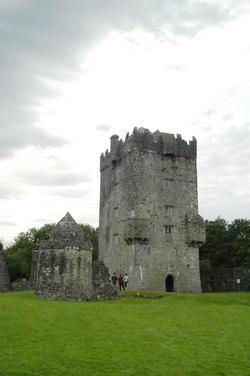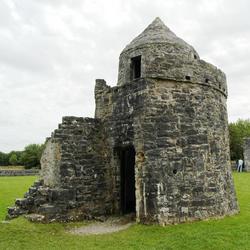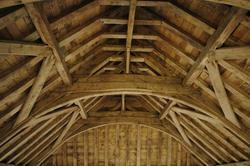
You are here:
Galway
>
Sights to See, Walks of Galway
>
Sights to See
>
County Galway
> Aughnanure Castle
Aughnanure CastleAughnanure CastleText supplied courtesy Dúchas - The Herigate Service. History Aughnanure Castle is one of well over 200 tower houses in County Galway built by large, wealthy, land owning families, mainly of Gaelic but some of Old English (Anglo-Norman) stock. Tower Houses are fortified residences and were places of power and control over the surrounding lands. The name Aughnanure comes from the Gaelic Achadh na nIubhar - the field of yews, of which one old specimen remains nearby. Situated on the banks of the Drimneed River, which flows into the wester side of Lough Corrib, 3km from Oughterard, the site was well chosen, as the river flows gently beneath the low cliff on which the castle was built, allowing boats bringing supplies to come righ tup to the gate of the fortification. The O'Flahertys had been temporarily expelled from their ancestral lands west of Lough Corrib in Connemara by the Norman family of De Burgos in 1256 and the original castle at Aughnanure may have been built by Walter de Burgo, first Earl of Ulster. However the expulsion of the O'Flahertys was only temporary and before the close of the 13th century and for the next three centuries, they were master of the entire territory of Iar-Connacht (West Connacht) extending from the west of bank of Lough Corrib to the sea. Aughnanure became their strongest bastion against their neighbours to the south and east, particularly the citizens of Galway who controlled access from the ocean to Lough Corrib. In the 13th century, the land around the mough of the Galway River was wrenched from the O'Flahertys by the Anglo-Normans who developed the town of Galway there. This remained in Anglo-Norman control throughout the later Middle Ages. The O'Flahertys never forgot the insult, and both land and used both land and water to harry Galway's citizens who regarded them as 'mountainous and wild people' by whom 'they were sometimes robbed and threatened.' In 1537, Lord Grey, King Henry VIII's Lord Deputy in Ireland, arrived in Galway to oblige the Irish chieftains to acknowledge the supremacy of the English monarch. Whild Grey remained in the town, the surrounding Irish chieftains, O'Flaherty, O'Madden and Mac Yeoris (or Bermingham) came in and made their submissions but did not give hostages. However, the citizens of Galway still felt threatened and the city's burghers erected a plaque over the western entrance to the town which read: This Gate was erected to protect us from the ferocious O'Flahertys. The epithets of the O'Flaherty leaders, such as 'the valiant' and 'of the wars' shows them to have remained at loggerheads with the city during the 16th century, and none more so initially than Morogh na dTuadh 'of the battle-axes' a minor member in the family hierarchy who frequently mounted raids on the territory of the English around Galway. Om 1564 at Traban, the white strand, about 3km west of Galway, he decisively defeated an expedition sent against him. In 1569, he accepted a free pardon for his 'offences' and although not of the senoir brance of the O'Flaherty clan, allowed himself to be appointed by Queen Elizabeth I as chieftain in the territory of Iar-Connacht over the head of hte legitimate chief othe the clan who lived at Aughnanure. In consideration of this, Morogh undertook to 'observe the Queen's peace' and learning of an uprising planned by his kinsmen, Morogh betrayed the plot to the English who sent Sir Edward Fitton, President of Connacht, to march against and take Aughnanure. Though defended by muskets, the castle was no match fot the artillery which its defences were not designed to resist. In 1572, the castle duly fell - for the only time in its long existence - and was delivered to Morogh who re-fitted and fortified it, giving it the form we see today. Later HistoryThe most distinguised of the descendants of Morogh was Colenel Morogh O'Flaherty, also nickneamed na d-tuadh, who played a determined part on the side of the Irish in the turmoil of the 17th century. In 1618, Aughnanure was granted to Hugh O'Flaherty by King James I but, by the middle of that century, it was occupied by the Marquis of Clanrickarde, who is known to hve written a number of letters from the castle in his campaign against the Cromwellian forces at that time. By 1687, the Earl of Clanrickarde allows the castle back into O'Flaherty hands for an annual rent of £76 and in 1719, it was tranferred entirely to Bryan O'Flaherty, who took out a mortgage on it for £1600, borwwing money from Lort Saint George who subsequently foreclosed on the mortgage and took possession of the castle. However, this see-saw change of ownership later turned out once more to the advantage of the O'Flaheties, and it was Peter O'Flaherty from whom the Commissioners of Public Works obtained the castle in 1952 before declaring it a National Monument and undertaking restoration of the parapet, chimney and roof in 1963. Aughnanure Castle is now managed by Dúchas The Heritage Service of the Department of the Environment and Local Government. The CastleThe castle, which stands on what is a rocky peninsula, is a particularly well preserved example of an Irish Tower house and has been described as "the finest fortified dwelling upon any part of the shores of Lough Corrib". Though the castle did finally succumb to superior cannow power, the O'Flahertys knew well enough how to protect themselves. The great rectangular Tower House is protected inside two alls or enclosures. The inner enclosure is wedge-shaped with walls perced with gun-loops. The remains of a gatehouse and drawbridge are at the northwestern corner. On the northern side, the Drimneed River adds a natural defence line. the outer ward considting of a large irregular encosuer protected by a much more extensive outer bawn wall, which had five wall towers at intervals along its length, to provide a greater variety of angles from which to shoot at attackers.  Much of the masonry of the inner bawn wall has been bemolished, but a small circular watchtower at the southeastern corner which has a very fine corbelled dome and a conical stone roof, indicates the original location of its outermose corner. A gallery encircling the top of the tower provided the sentry on duty with a complete view of the whole courtyard and its surrounding external walls while the gunports in the curving wlls are a stark reminder of its once-defensive intent. The Tower-house, with battlements in the Irish style, is sited almost centrally within the inner courtyard. It is certainly on of Connacht's tallest, rising to a total of six storys above a battered or sloping base. The decorative doreway is on th eastern side away from the entrance gate to the inner bawn. High above the doorway is a machicolation, a projecting piece of masonry, from which arrows could be fired or stones dropped on intruders. Other projections, known as bartizans, where palace at third floor level, on the corners of the east wall. These were provided with gun loops for muskets.  Inside the doorway there is a guard's cublicle to the right and a stone spiral stairs rising to the upper apartments to the left. Just inside the entrance a "murder hole" allowed defenders to drop stones on any enemy who managerd to enter the castle. The ground floor was used as a storeroom and for servants who would have slept in some ofht elow rooms sandwiched horizontally between the larger rooms. Othe rooms would have similarly been used by family members whos days were spent in the large room on the third floor, where a blazing fire in the grand fireplace, send smoke up through the shimney which rises high above the restored hipped roof. the uppermost floor, with its wide mullioned windows is probably where the chieftain wold have held court. It is now covered with a well-crafted oak roof with timbers joined by wooden dowels. The opening in the garderobe florr at this level is the only entrance to a secret chamber. This was in the haunch of the vault betwwen the floors where prisoners could be incarcerated. The battlements were reached via the stairway door in the top floor and the wall walk provided a fine field of view for the defenders of lake and surrounding countryside. Near the south-eastern corner of the outer bawn, stand the remains of the east wall of the once thatched Banqueting Hall. The remainder of the hall fell with the collapse of the natural arch over the river on which the Banqueting Hall had been built. The one remaining wall contains two windows beautifully decorated inside and out with stone carvings. The sofffit of one of them bears soe stiff carvings of grapes, suggesting that wine was quaffed there by the O'Flahertys, and particularly by Morogh, who may have imported it from France and Spain through the city of Galway. It is said that unpopular guest swere sometimes disposed of through a trap door into the subterranea river which ran under the hall! Admission Charges and Opening HoursOpen from late spring to early autumn. Open 09:30 - 18:30. Car/coach car park nearby. Toilet facilities on site. Wheelchair access limited. Adult: EUR 2.75 Bats of AughnanureThree species of bat use Aughnanure castle as roost. Most are Daubenton's bats but a few Long-Eared and Pipistrelles bats are also present. The castle is used as a maternity roost, where the female bat gives birth to a single offspring in early summer. Sometimes baby bats crawl out of the crevices and are found on the castle floor, but in general they are never seen during the day and can only be heard through the castle walls. Bats are and endangered species and are protected by Irish and EU legislation. During the day the bats are rarely seen and can only be heard though the walls of the castle. Related Links
|